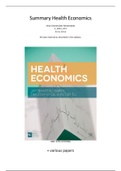Samenvatting
Summary Health Economics Minor Health Care Management VU Amsterdam
- Instelling
- Vrije Universiteit Amsterdam (VU)
- Boek
- Health Economics
This summary contains all the exam material for the course Health Economics as part of the Minor Health Care Management at the Vrije Universiteit Amsterdam. It also contains the papers described in the tutorials!
[Meer zien]






